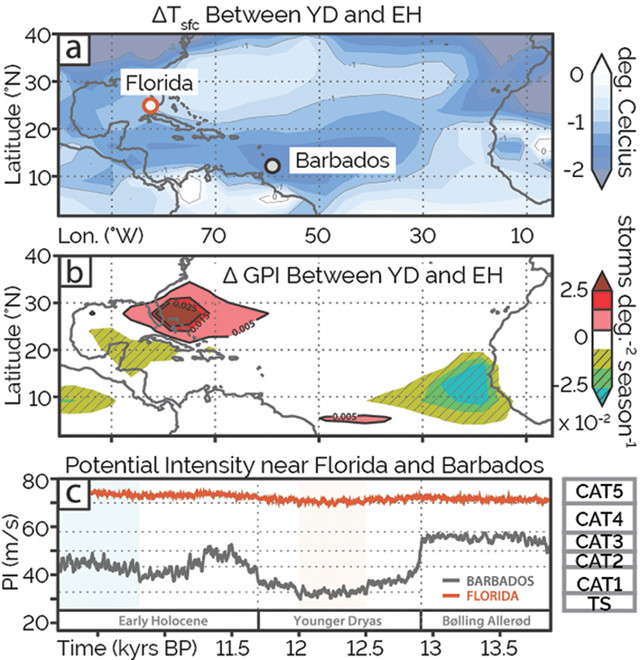
by Mary Caperton Morton Friday, January 12, 2018

Seafloor sediment cores spanning the Younger Dryas (YD) into the warmer early Holocene (EH) suggest that, during the Younger Dryas about 12,000 years ago, sea-surface cooling (a), which tends to suppress hurricane formation, was less prominent near Florida than it was farther south in the tropics, near Barbados. The potential frequency (b) and maximum intensity (c) of tropical storms were also higher by Florida. Credit: Toomey et al., Geology, October 2017.
A new study looking at turbidites off the coast of Florida shows that category 5 hurricanes may still have battered Florida even during the chilly conditions of the Younger Dryas, about 12,000 years ago, at the end of the last ice age.
Turbidite deposits in the Bahamas have been linked to modern hurricanes, when storm surges set off underwater landslides that create a record of storm events. In the new study, a team led by Michael Toomey of the U.S. Geological Survey in Reston, Va., collected sediment cores offshore of Florida’s Dry Tortugas. The researchers found ample evidence for hurricanes during the Younger Dryas, when air and sea-surface temperatures are known to have dropped by up to several degrees Celsius across much of the Northern Hemisphere. The finding came as a surprise, as cooler water temperatures tend to stifle the formation and intensification of cyclonic tropical storms.
“Despite potentially hostile conditions for cyclogenesis in the tropical North Atlantic at that time, our records and numerical experiments suggest that strong hurricanes may have regularly affected Florida,” the team wrote in Geology. Based on paleoclimate modeling, the team credited other effects of the Younger Dryas cooling — namely, slowed ocean circulation and accompanying impacts — with overcoming the hurricane-suppressing effects of cooler sea-surface temperatures. Today, the Atlantic Meridional Overturning Circulation (AMOC) transports cooler water south and warmer water north. But during the Younger Dryas, the AMOC is thought to have been much weaker, slowing circulation and reducing cooling of midlatitude surface waters.
© 2008-2021. All rights reserved. Any copying, redistribution or retransmission of any of the contents of this service without the expressed written permission of the American Geosciences Institute is expressly prohibited. Click here for all copyright requests.